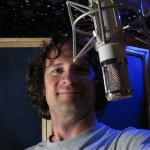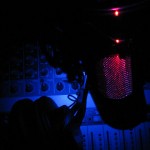 I had a great time doing an Interview with Bill DeWees. Check it out and look for more from Bill on his VoiceOverExpert You Tube Channel.
I had a great time doing an Interview with Bill DeWees. Check it out and look for more from Bill on his VoiceOverExpert You Tube Channel.
Thank you, Bill!
by Dan Friedman
 I had a great time doing an Interview with Bill DeWees. Check it out and look for more from Bill on his VoiceOverExpert You Tube Channel.
I had a great time doing an Interview with Bill DeWees. Check it out and look for more from Bill on his VoiceOverExpert You Tube Channel.
Thank you, Bill!
by Dan Friedman
 A radio or television commercial is more than just words. The space between the lines helps to determine pace and establish mood. Space allows the mix engineer to create an environment in which the voice exists and where music and/or sound effects can be placed to help tell the story and communicate the message. This space and these elements are often key to the production.
A radio or television commercial is more than just words. The space between the lines helps to determine pace and establish mood. Space allows the mix engineer to create an environment in which the voice exists and where music and/or sound effects can be placed to help tell the story and communicate the message. This space and these elements are often key to the production.
Scripts often indicate that sound effects and music will play a key role at certain points within in a radio or TV production. These notes are great for the producer or engineer who mixes the spot. They give the mix engineer a clear idea of what the intentions of the client are and what the client is expecting to hear when the spot is finished.
However, what happens all too often is that the script is over written, leaving little or no time available for these elements to develop. They simply can’t have the impact they were intended to have. If a script, read out loud, is taking all of the time available, then what time is left for the music and sound effects to perform their role? Worse yet, the voice talent may feel forced to alter their speed or delivery to accommodate these elements. This may prevent the voice talent from communicating the message in the most effective way possible.
While there is little doubt that the message (the actual spoken words) should be the focus of most commercial audio productions, writing less copy provides space for music and sound effects to help communicate that message. In fact, these elements combined with the delivery of the voice talent, can often do more to communicate the overall message than including additional words in a script.
Radio and TV spots must fit into a specific time frame, usually :30 (:29.5 for TV) or :60 seconds. While these times are important, taking the time that will be needed for music and sound effects into consideration while writing and preparing a script can also be critical to your bottom line. The time saved in the studio by having a carefully written and timed script before recording begins, is time and therefore money saved.
Clients may insist on getting all of their critical information into a spot. But ultimately, clients want people to act (or buy something). Creative “ear catching” commercials are often more memorable and influential then a long string of words being forced upon a listener. The space between the lines, allows creativity to flourish.
Even if additional elements are not part of your radio or TV commercial, proper spacing and pacing will allow the listener to think about and hopefully act on what is being communicated to them.
by Dan Friedman
 While there are many elements to producing great voiceovers, few are as important as the room you produce them in. While it is important to carefully evaluate the sound of your room when it is completed, there are some basic things to consider in the beginning that will help ensure your space will sound great in the end. Here are some quick tips on choosing and creating your VO space.
While there are many elements to producing great voiceovers, few are as important as the room you produce them in. While it is important to carefully evaluate the sound of your room when it is completed, there are some basic things to consider in the beginning that will help ensure your space will sound great in the end. Here are some quick tips on choosing and creating your VO space.
Location
The space you choose should be a quiet place. Basements can be a good choice because they are often underground. Upper levels can also be a good choice because they are free from noise overhead. Spaces in your home farthest away from roads or other sources of outside noise are ideal. Begin by picking the right location based on what is available to you, and you will be off to a good start.
Size
You need a space that is comfortable and capable of containing you and your equipment. At a minimum you need room for yourself, a microphone, microphone stand and a copy stand and/or computer monitor. You may also wish to have a chair and some of your equipment in the space with you (the quiet pieces only please).
Dimensions
It is important to consider the dimensions of your room. Because of the way sound travels, square rooms are bad. Ideally the dimensions will be different or not evenly divisible by one another.
Sound Proofing
In a home studio setup, it can be difficult to completely keep outside sounds from entering your recording space. This is why choosing the best location is critical. If you are building your space, you’ll want to isolate it as much as possible by separating it from the rest of your structure. Using double thick walls, creating air-gaps between walls and floating the floor are commonly used methods. Think of it as building a room within a room. If you are simply creating a space or using a prefabricated “voice booth”, keep it away from noisy household equipment and keep all of your noisy studio gear (anything with a running fan) outside of the room and away from the voicing area.
Acoustic Treatment
Treating the acoustics within your space is the final step. There are many products on the market that can help you with this or you can create your own. Acoustic foam panels of various sizes, thicknesses and shapes are just one of several options (panels made from mineral wool fiber covered in burlap are my personal choice.) Whether you are using pre-cut foam, buying other acoustic control materials or creating your own acoustic panels, the thickness of the panels determines what frequencies they work best to control. To tame bass or low frequencies you need thick panels, usually no less than 6 inches thick. For mid range and higher frequencies 2 and 3 inch thick panels will usually do the job. Absorbent materials and varied surfaces (such as pyramid or triangle shapes on foam) help to reduce reflections that cause a room to sound reverberant.
Location, size, dimensions, soundproofing and acoustic treatment are the fundamental considerations. This article is meant to get you thinking about these elements as you work on your voiceover recording space. For more in-depth information about room acoustics and sound treatment I recommend the following links:
Acoustics101.com
GIKAcoustics.com
RealTraps.com
For more information about sound and how it relates to your voiceover career check out: Sound Advice – Voiceover From An Audio Engineer’s Perspective.
It is important to understand that effective sound control requires that you utilize space and use materials that have mass. While there are several products available that wrap around your microphone or even you and your microphone, none of these are as effective as treating the room you are in properly. If you are serious about your career in voiceover you will get serious about your room. Other than your voice, nothing is more important to your sound than your recording environment.
by Dan Friedman
 Good communication is a key to success in all relationships. Often miscommunication and misunderstandings between people occur because they simply don’t know how to “speak the same language”. I’m not talking about the difference between English and Chinese. I’m talking about technical audio terms. In the business world, nearly every type of business, has a name for everything they do. The recording and voiceover world is no different.
Good communication is a key to success in all relationships. Often miscommunication and misunderstandings between people occur because they simply don’t know how to “speak the same language”. I’m not talking about the difference between English and Chinese. I’m talking about technical audio terms. In the business world, nearly every type of business, has a name for everything they do. The recording and voiceover world is no different.
In an effort to overcome the “language barrier” that often exists among engineers, directors, clients and talent, my friends and I have put together a glossary of voice over studio terms that everyone in this business should know.
While individual studios and production companies may also have unique terminology that is used internally, this list will provide you with key terms that are fairly universal throughout the industry.
Enjoy!
AUDIO TERMS and DEFINITIONS
ADR – (Automated Dialog Replacement) Also referred to as ʻloopingʼ. The process of replacing a voice over for an on-camera talent.
Compression – The use of an audio processor to control audio dynamics (loudness and softness) on a piece of audio. It can be arcoxia 90 applied to individual parts as well as to an overall production.
Data compression – Process designed to reduce the transmission bandwidth requirement of digital audio streams and the storage size of audio files.
De-breathing – The process of removing all breaths from a vocal performance.
Editing – The process of removing unwanted portions of audio, leaving only the portion that will be used in the final production. May or may not include de-breathing.
Equalization (EQ) – The use of an audio processor to manipulate the frequencies that exist within all sounds heard by the human ear.
Audio File Formats – Common uncompressed audio file types used in audio production are: AIFF & WAV. Compressed audio files are typically MP3.
ISDN – Integrated Services Digital Network – A communication standard allowing the transmission of voice (as well as video and data) from one studio to another over telephone lines in high speed, digital quality and with great fidelity.
Limiting – The use of an audio processor to keep audio from exceeding a certain level or threshold as determined by the engineer.
Maximization or Maximize – A mastering process that includes the use of an audio processor to bring audio up to a maximum level as determined by the engineer.
Mix – A fully produced, finished or broadcast ready audio presentation that may include voice, music, sound effects, all necessary processing and maximization. Usually provided in stereo unless the final format is mono only (such as a phone system)
Mixing – The process of manipulating and combining multiple audio signals or elements to create a final audio production or mix.
Noise – Any sound that is undesirable or unwanted.
Normalize – To increase or decrease audio levels to a fixed point based on the peak point or RMS equation.
Processing – Any alteration of raw audio through the use of audio tools such as compression, equalization (EQ), maximization, or time- based/space-based effects (i.e. – delay or reverb).
Raw Audio – Any recorded audio that is unedited and unprocessed. Delivery of “raw audio” means to provide clients with audio exactly as it was recorded.
Reverb – A space/time based effect that simulates an environment. All environments have an effect on a sound within that environment.
Example: A voice heard in a stadium sounds different than a voice heard in a closet. Reverb can be used to simulate the sound of both environments. Some people refer to this as “echo” (IMPORTANT NOTE: the use of reverb is very dependent on an overall production and therefore is rarely added unless a full mix is being produced).
Sample Rate/Bit Rate – Essentially the amount of digital information used by the computer in the creation of an audio file. The higher the rate, the higher the supposed quality of the file. However, beyond a certain point (for most people above 44.1kHz/16 bit) the difference in sound quality is undetectable. Therefore, the need to obtain/verify this information becomes necessary primarily for compatibility among files or systems.
44.1kHz/16bit = CD quality audio
48kHz/16bit = Video standard for audio
Slate – A recorded audio cue that identifies the audio that follows. Generally stated as, “take one (followed by the recorded VO), take two (followed by the recorded VO) take three…” etc.
Stems – Individual elements of a mix provided separately. Voice, music, and sound effects provided as separate files instead of combined in a full mix.
Takes – A separate file of recorded audio. Each take is identified by a separate file name and a slate.
Time Compression/Expansion – An electronic process using an algorithm which leaves the pitch of the signal intact while changing its speed (tempo)
©2025 Dan Friedman Sound4VO // Voice Over Site by Voice Actor Websites